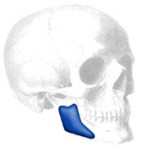
In many cases of facial asymmetry the most common finding or cause is that the lower jaw is different between the two sides. Because the lower jaw is moveable (the only facial bone to do so) and has an L-shape in the back above which the jaw joint hinges, it is the one facial bone that is most prone to having differences between the two sides. Most commonly, these differences are back at the angle area and along the jawline that comes forward. This can create a very visible difference between the jawlines when looking straight forward. It is the most common type of facial asymmetry that I see. Sometimes I will see someone who has a crooked chin, where the chin point if offline, but the origin of the crooked chin usually comes from differential jaw growth between the two sides.
In cases of facial asymmetry it is initally important to make sure that the jaw asymmetry is not best corrected by actually moving the whole jaw and putting the teeth into a better bite relationship. If one is young and the jaw asymmetry is significant, how the teeth come together will determine if this is the best long-term solution. But assuming that jaw bone movement is not a good solution, the more common approach is to correct it with the placement of implants.
Jaw angle and jawline implants can be fairly simple methods of improving jaw asymmetry. These implants are almost always placed through inside the mouth. Off-the-shelf jaw angle implants exist but there is no off-the-shelf jawline implant. Jawline implants have to be fashioned at the time of surgery, usually out of a block or thick sheet of semi-soft material. (Gore-tex or SAM is what I prefer) The key to success with implant augmentation is to be certain of exactly where the jaw asymmetry is. Implants will do little good if they aren’t in the area of bone deficiency or asymmetry. Sometimes this is obvious by feel, other times it may be better to get a 3-D CT scan and have an exact skeletal image to work off of. In rare cases, I have even had a 3-D model made from the CT scan and custom-fabricated the shape of the implants prior to surgery. This is the most exacting method but also the most costly.
When having implants placed for any type of facial asymmetry it is important to walk into surgery with the understanding that the outcome will be better…but not perfect. Surgical facial augmentation with implants is as much an art as it is an exact science.
Dr. Barry Eppley
Indianapolis, Indiana


